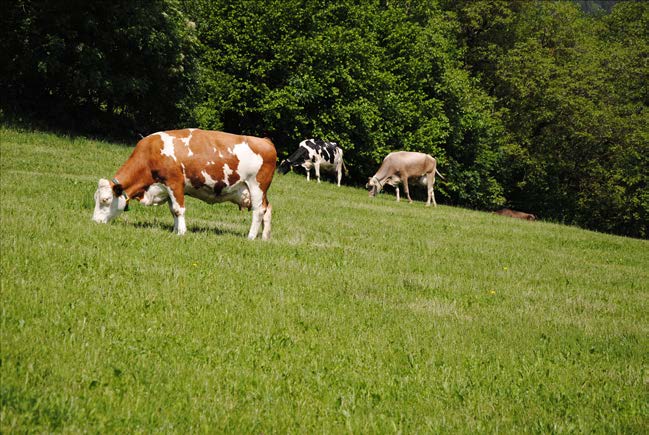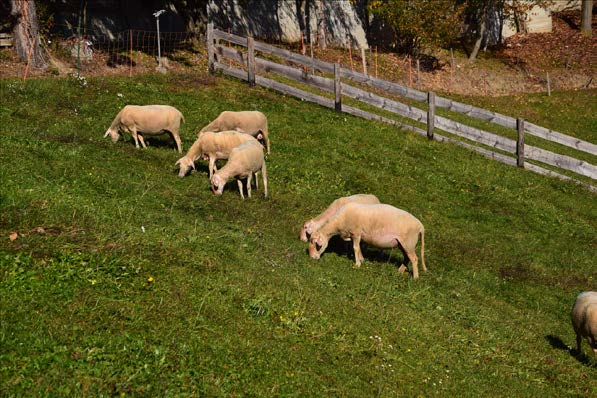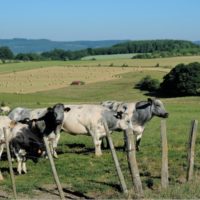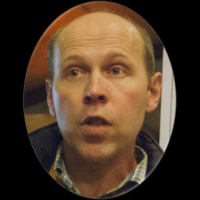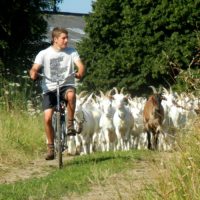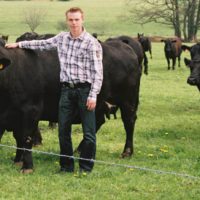Short sward grazing and production of organic haymilk
Reduction of concentrates and extensive milk production
Farm: “Professional School for Agriculture and Home Economics Salern”
Location: Vahrn/Varna (South Tyrol), Italy
Case study
 Short sward grazing and production of organic haymilk (.pdf)
Short sward grazing and production of organic haymilk (.pdf)
Description
Background
Although grassland farming in South Tyrol is mainly limited to mountain areas and farms are often small, the intensity with which farmers run their dairy farms is often very high. The high milk yield per cow is achieved by means of a high animal load in terms of livestock units per hectare and an indoor feeding system with large use of concentrates. The organic farm is part of the Professional School for Agriculture and Home Economics Salern and is owned by the Autonomous Province of Bozen/ Bolzano. As a farm belonging to an agricultural school, the farm fulfils a didactic function too. For this reason, sustainable management is a pivotal issue, as the farm should serve as a model for the future farmers’ generation. All employees are aware of their role as trainers of the ‘farmers of the future’ and accordingly try to take on a pioneering role in the way they operate, even if this is often skeptically and critically viewed by other farmers. For sustainability, it was important to extensify the originally intensive milk production on the farm. In 2005, the first step was therefore to switch from conventional to organic farming. The integration of grazing into the farm’s workflow was primarily intended to improve animal welfare. A further extensification is aimed at by the farm. Therefore, in the last years, the amount of given concentrates was continuously reduced. By now, only 450 kg of a grain mixture is fed per cow and lactation, whereby this quantity is to be further reduced in the coming years. Moreover, haymilk is produced without feeding any silage.
This reduction in the concentrates use is an important concern for the educational farm for both economic and, in particular, ethical-ecological reasons. In developing countries, no arable land should be wasted on the cultivation of animal feed which would actually be suitable for the cultivation of human food and thus for nourishing the local inhabitants. Moreover, the reduction in the concentrates use results in a greater independence from the forage market and its price fluctuations.
Detailed description
As part of the conversion to organic farming, the stable was first rebuilt and a loose housing for the dairy cows was established instead of the tie-stall. Then, the pasture was integrated into the farm’s operations. Currently, a combination of mowing and short sward grazing (German: Kurzrasenweide) is used. However, the whole pasture area is not available constantly to the animals, but it is divided into paddocks. This is mainly necessary because a public road running through the grassland areas of the farm does not allow for a free movement of the animals.
In spring, the animals are first given access to the largest uninterrupted grazing area close to the farm. As soon as the grass growth rate rapidly increases, about half of the area close to the farm is divided into four paddocks. The animals remain on each paddock for two days and move then to the next one. This results in a rest period of six to seven days for the grazed area before it is grazed again. At the same time, the second half of the grassland area is not grazed and mown instead for hay production. After one and a half months, the herd is moved to these areas and the regrowth is grazed. The already grazed areas are fertilised with slurry and the regrowth is mown at the beginning of July after a growth period of about six weeks.
Starting in the last season, the dairy cows were brought from end-June to mid-September to summer pastures at high altitude. This was primarily done to reduce the workload during the summer months. Between end of June and mid-September the areas close to the farm buildings are exclusively mown.
From mid-September to end-October, the animals graze again on the grassland located near to the farm. During this time, the management of the pastures is flexibly adapted to weather conditions, regrowth and livestock. In contrast to spring, either the grazing area made available is increased or the stocking time per area is reduced. From the end of October on, the animals remain in the loose housing during the winter months.
For didactic reasons, four dairy breeds (Braunvieh, Simmental, Tyrolean Grey and Holstein Frisian) as well as dairy sheep of the Lacaune breed are currently kept on the farm. For the sheep, a deep litter stable was built for the winter months. During the summer months, they remain for 150 days on the pasture all day long, whereby the system of flexible paddock and rotational stocking is used.
Since last year, the calves are born on the farm, but they remain on the farm only during the suckling period and are then transferred to another farm. They do not return on the farm until they are adult dairy cows. This was done for several reasons: workload and space problems are reduced; a larger proportion of the feed ration can be covered with the farm’s own feed and the off-farm purchase of forage can thus be further reduced. However, this also requires a high quality of the roughage, which is achieved by warm ventilation and a dehumidifier.
A special feature of the farm has been until last year the mixed grazing with milk sheep and the young cattle. The aim of it was to reduce the parasite pressure. Mixed grazing of dairy cows and dairy sheep would not be possible, as the sheep graze areas with slopes of more than 25% and the dairy cows would cause trampling damage there.
A large part of the produced cow’s milk is delivered to the dairy as organic haymilk, and is currently paid with 0.83 € per litre. The rest of the cow’s milk and the sheep’s milk is processed into cheese and yoghurt and sold in the school’s farm shop. Customers are mainly the students as well as participants to the education courses held at the school.
Advantages
The changes in the management method reduced the amount of labour. The relocation of the young cattle and the grazing of the dairy cows on alpine pastures reduce especially in the summer months the workload. On the one hand, this makes it possible to concentrate on the forage harvest at the farm. On the other hand, it enables the two permanent employees to take holidays also during the summer months.
Adoption criteria
The organization and procedures on the farm are quite complex. Many aspects are only implemented for didactic reasons and would therefore be difficult to realise on small farms. For example, two milking parlours are needed, one for the dairy cows and one for the dairy sheep. In addition, two permanent employees are working full-time throughout the whole year. If, however, the small farms would concentrate only on the dairy cows or on the dairy sheep, individual aspects of the management system could certainly be implemented by them.
The prerequisites for the implementation are moderately steep grassland areas close to the farm, livestock breeds and lines that are suitable for grazing and that can cover their own energy requirements with grazing and hay, as well as an existing market for organic haymilk and farm products. In addition, farmers should be convinced of the usefulness of reducing concentrates and be ready to face a learning phase concerning grazing management.
Future prospects
For the future, it is an essential concern to achieve self-sufficiency in terms of meeting the own forage needs. For this reason, the feed ration will be continuously adjusted and the proportion of concentrates progressively reduced. In order to achieve this goal, however, suitable animal breeds and lines are also required. New breeds such as Original Braunvieh and Pinzgauer will be added to the animal herd in the future.
In order to increase animal welfare, the dehorning of the animals will be completely omitted in the future. In addition, mixed grazing with sheep and cattle will be reintroduced. The number of dairy cows kept shall be increased considerably. Since no more young animals are kept on the farm, this is also possible without an excessive increase in the stocking rate. In addition, there is a plan to establish a mother-bound rearing of calves in the future.
Additional information
| Farming system | organic farming |
|---|---|
| Domains of innovation | animal feeding management, grazing management system |
| Main types of animal | dairy cattle, dairy sheep |
| Country | Italy |
| Product type | Case study |
| Language | English |
You may also like…
-
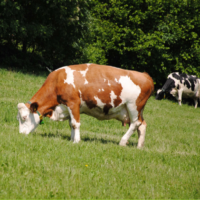
Grazing management with dairy cows and sheep in mountain areas, reduction of use of concentrates
Read more -

Grazing management with dairy cows and sheep in mountain areas, reduction of use of concentrates
Read more -

Grazing management with dairy cows and sheep in mountain areas, reduction of use of concentrates
Read more

